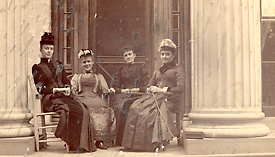From “Date Bait” hats to parachute pants, campus clothing trends from the 1880s to 1990 are celebrated in the current Bentley Historical Library photo exhibit “Varsity Vogue: Women’s Fashion at the University of Michigan.”
The exhibit is presented from 9 a.m.-5 p.m. Monday through Friday and 9 a.m.-12:30 p.m. Saturdays through March 31.

In the days before dormitories and common eating settings, Alpha Phi sorority members in 1887 display the latest fashions as they convene a meeting of their “eating club,” on the porch of the Wilson-Wahr house at the corner of Division and Ann Streets. The photo is featured in the exhibit “Varsity Vogue: Women’s Fashion at the University of Michigan.” Photo by Courtesy Bentley Historical Library.
Exhibit organizer Emily Sanford, a graduate student at the School of Information where she studies archives and records management, was working as a graduate student assistant at the Bentley Historical Library. Karen Jania, head of reference, asked her and fellow graduate student assistant Beth Myerowitz to propose and mount an exhibit.
“We really wanted it to be interesting and fun. Beth and I met to look over past exhibit themes and to brainstorm new topics based on our interests and familiarity with collections,” Sanford says.
She found that when poring over vintage photos, the clothing would draw her attention. “I think it says a lot about the time period and the individual being photographed,” Sanford says. “We proposed women’s fashion because it had never been done before and we knew that we could draw on multiple collections to really inform the exhibit.” These included the Alumni Association Records and the Department of Physical Education for Women Records.
Among the first exhibit photos presented in four display cases at the Bentley Library is one from the 1880s. Four women students, in ankle-length skirts and long-sleeve blouses, sit at a table on the porch of the Alpha Pi house. The women are at a session of their “eating club.” Sanford says such clubs were common, at a time before dormitories, when students stayed in private rooms and sought opportunities to join together in activities outside of learning.
One photo from 1911 shows a group of women sporting “Gibson Girl” hairstyles — a bun puffed out on the sides above the neck. A sorority photo from the 1930s shows most of the women wearing oversize neck bows that nearly reach from shoulder to shoulder. A World War-II era photo of women bundled in winter coats along the walk outside Angell Hall indicates most have fur-trimmed collars.
A 1943 photo displays nursing students playing cards, wearing sweaters with skirts and penny loafers. The large neck bows are gone, replaced by pearl necklaces. By the early 1950s, photos show women students favoring rounded Audrey Hepburn collars.
The exhibit also includes period clothing advertisements from student publications. “My favorite example is the ‘date bait hat,’” Sanford says. It was a small women’s fur or felt hat depicted in a 1941 ad. The hat was meant to draw attention and, therefore, dates.
“I was especially drawn to the photographs from the 1920s,” Sanford says, a time of less formal fashion for women, marked by dresses with hemlines just below the knee and cloche hats. “I actually had to check myself to make sure I was not overly representing that time period. I would wear those clothes in a heartbeat, especially the hats. I am less drawn to the more recent trends, such as parachute pants, but maybe that’s because we are not far enough removed from those trends.”
While the exhibit does not formally collect viewers’ comments, Sanford says one person spotted one of her favorite aunts in a photo of two students posing on bikes in the 1920s. “She was very excited and ordered a print of the photograph,” Sanford says. “That has been my favorite feedback thus far. I don’t know how you top that.”

